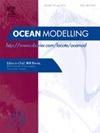低功耗计算跨洋波传播,减轻海啸危害
IF 2.9
3区 地球科学
Q2 METEOROLOGY & ATMOSPHERIC SCIENCES
引用次数: 0
摘要
本文提出使用基于现场可编程门阵列(FPGA)微芯片的专用硬件加速器来计算海啸波的传播,以评估和管理海洋自然灾害的风险,即水下地震引起的海啸波。在发生足够强烈的地震事件后,许多国家和研究中心会进行大量计算,估算海岸某些地区的海啸波参数,以确定是否有必要宣布海啸警报。这需要很高的计算能力,从而导致更高的能源成本。本文展示了如何利用安装在个人电脑(PC)上的基于 FPGA 的特殊计算器(作者早先已提出该计算器的结构)来计算海啸波在整个太平洋(从堪察加半岛和千岛群岛近海的俯冲带到智利海岸)的传播。这种计算在几分钟内就能得出可靠的结果,并能获得沿岸海啸波高的预期分布。如果得到的结果表明海啸会对居民造成危害或可能破坏基础设施,就必须进行更详细的计算,以准确估算预计会产生负面影响的沿岸特定地点的波浪参数。这需要集群和/或超级计算机系统,这些系统耗能巨大,因此价格昂贵。如果模拟结果表明沿海人口稠密地区的最大波高值较小,就可以立即通知近岸地区的居民海啸波幅较小,不需要进行更详细的研究。因此,这可以明显节省能源消耗。本文介绍了利用基于 FPGA 的硬件加速计算机代码执行,在个人计算机上计算海啸波在太平洋上传播的情况。本文章由计算机程序翻译,如有差异,请以英文原文为准。
Low power computation of transoceanic wave propagation for tsunami hazard mitigation
This paper proposes the use of specialized hardware accelerator based on the Field Programmable Gates Array (FPGA) microchip to compute tsunami wave propagation to assess and manage risks of marine natural disasters, namely, tsunami waves caused by underwater earthquakes. After a sufficiently strong seismic event, many countries and research centres launch extensive computations to estimate the tsunami wave parameters in certain parts of the coast to determine if a declaration of a tsunami alarm is warranted. This requires high computating powers which leads to higher energy costs. The paper demonstrates how an FPGA-based special Calculator (architecture of which has been earlier proposed by the authors), installed on a Personal Computer (PC) could be used to calculate the propagation of a tsunami wave over the entire Pacific Ocean, from the subduction zone offshore Kamchatka Peninsula and Kuril Islands to the coast of Chile. Such calculations offer reliable results within a few minutes and make it possible to obtain the distribution of expected tsunami wave heights along the coast. If the obtained results indicate a danger to the population or possible destruction of infrastructure, it becomes paramount to carry out more detailed calculations to accurately estimate the wave parameters at specific locations along the coast where negative consequences are expected. This requires cluster and/or supercomputer systems, which consume significant energy and hence are expensive. In case the modelling results indicate small values of maximum wave heights at populated coastal areas, population of the near-shore regions can be immediately informed about low amplitude tsunami wave; more detailed studies are not needed. This hence leads to noticeable savings in energy consumption. The paper presents a calculation of the propagation of a tsunami wave across the Pacific Ocean on a personal computer using a FPGA-based hardware acceleration of a computer code execution.
求助全文
通过发布文献求助,成功后即可免费获取论文全文。
去求助
来源期刊

Ocean Modelling
地学-海洋学
CiteScore
5.50
自引率
9.40%
发文量
86
审稿时长
19.6 weeks
期刊介绍:
The main objective of Ocean Modelling is to provide rapid communication between those interested in ocean modelling, whether through direct observation, or through analytical, numerical or laboratory models, and including interactions between physical and biogeochemical or biological phenomena. Because of the intimate links between ocean and atmosphere, involvement of scientists interested in influences of either medium on the other is welcome. The journal has a wide scope and includes ocean-atmosphere interaction in various forms as well as pure ocean results. In addition to primary peer-reviewed papers, the journal provides review papers, preliminary communications, and discussions.
 求助内容:
求助内容: 应助结果提醒方式:
应助结果提醒方式:


